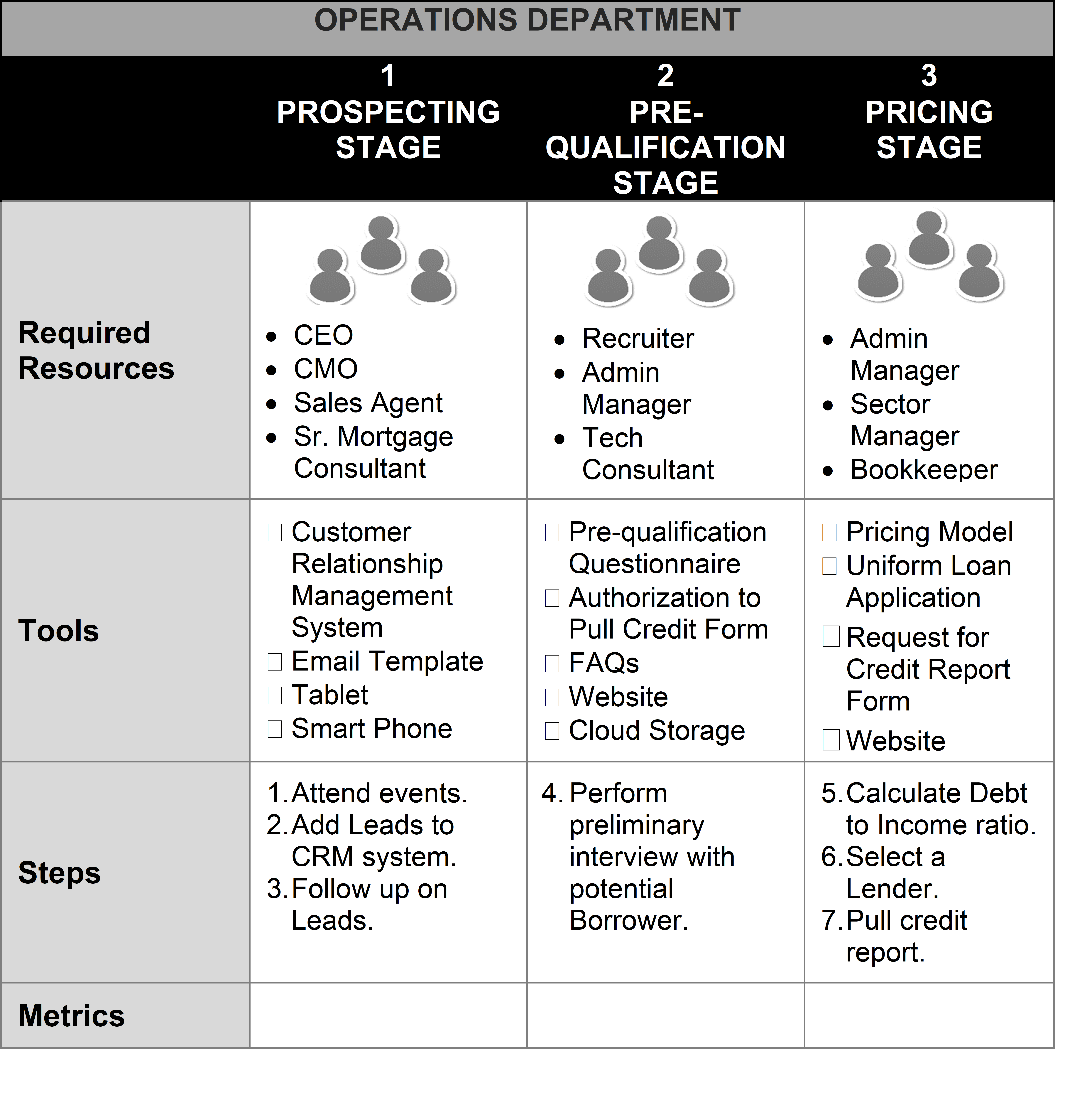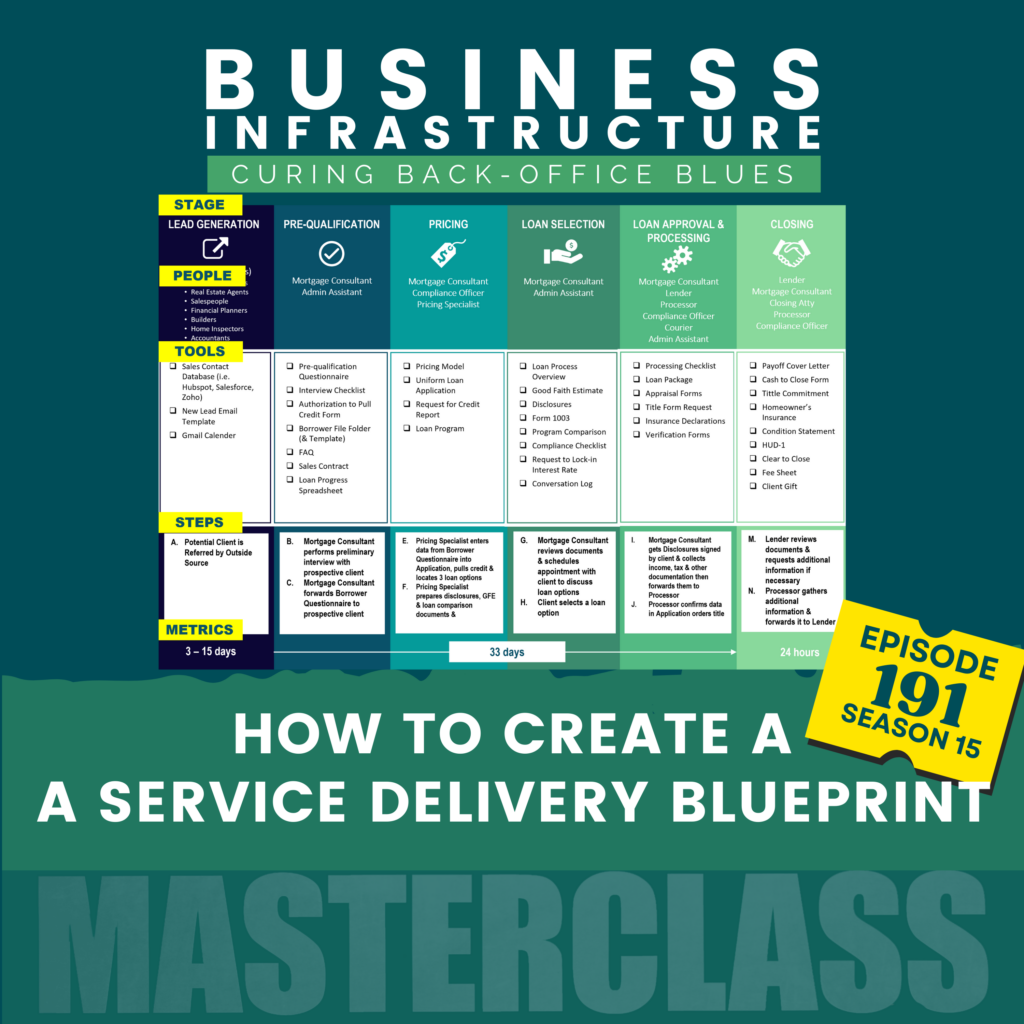Transcript
In the last episode you heard the story of Vandana Thiagarajan. She’s in business, not only with her best friend, but her husband too. And they all live together. This adds a unique complication to how they manage and balance their personal lives with their business.
In fact, their conflicting objectives are on the verge of boiling over. That’s why their consultant, Hunter, steps in to introduce them to business infrastructure. He shows them how to create a service delivery blueprint, a handy tool that as Vandana and her co-founders discovered is the visual summary they’ve been missing to get back on track, fully aligned, and with the ability to fulfill promises made to their customers.
I’m Alicia Butler Pierre, and I’m about to teach you how to create a service delivery blueprint for your business. If you follow along, by the end of this episode, you’ll also have a visual summary that communicates exactly how you provide your goods or services and how long it takes to do it. Get ready to be wowed at what you discover. It’s time for our next class.
This is Season 15, Episode 191. How to Create a Service Delivery Blueprint.
Let’s start the show.
Welcome to Business Infrastructure, the podcast about curing back-office blues of fast-growing businesses. If you’re a business owner or operator looking for practical tips and solutions to scaling your business in a sustainable manner, you’re in the right place. Now here’s your hostess, Alicia Butler Pierre.

How does your service work? What’s the next step? How long will it take before I receive my order? If you’re tired of answering the same questions over and over about what you do, how you do it, and when it’ll be ready, then a service delivery blueprint might be just the solution for you. If you recall from the story of Vandana, she’s frustrated because they’ve historically promised to process alone in 33 days or less, but lately she and her co-founders haven’t been able to keep that promise and is threatening their reputation. Without having a clear way of articulating her frustration, she’s unable to get her co-founders to understand the severity of the situation. There’s so much value in something we in the world of Lean Six Sigma call, visual control. And in fact, I have a personal mantra. If you can’t fit it onto one page, then you probably don’t understand it.
Let me tell you why I say that. Sometimes, you must document information in a concise, highly visual way so that people can quickly understand the key issues and make decisions accordingly. And that’s where a service delivery blueprint can help. So what is a service delivery blueprint? A service delivery blueprint documents the people, the process, and all of the tools and technologies necessary to provide your core product or service. It’s a holistic view that shows how everyone in your company gets involved, or at least provides some level of support in providing those goods and services to your customers. It’s something that I first conceived and created many, many years ago, and it’s different from a regular standard operating procedure or a flow chart, a process map, or even a value stream map. It’s different because it’s specifically designed to fit onto one page, offering that high level overview of all of those critical elements of business infrastructure.

In fact, it represents the fifth element of the Kasennu Framework for business infrastructure. And if this is your first time ever listening to this show, business infrastructure is a system for linking people, processes and tools into a cohesive framework, allowing you to scale sustainably and profitably. There’s eight main steps I’ll describe for creating a service delivery blueprint. And as with the previous episodes in this audio masterclass, I’ll do my best to try to describe how to create it in a purely audio format, as well as describe what it looks like. But if you want to see an example, then I definitely suggest getting my book. It’s called Behind the Facade: How to Structure Company Operations for Sustainable Success. And if you look at Chapter Six, you’ll see that example format that I just mentioned. So let’s go ahead and get started.
Step number One is prepare. Now, unlike the other exercises that you’ve learned in the masterclass up to this point, there actually aren’t any visual aids associated with creating your service delivery blueprint. Yes, of course, there are ways you could try to work in some of the index cards and maybe even the stick figures, but for the most part, we will not be using any visual aids. So considering that, you’ll definitely need a computer laptop or a tablet, I would prefer a computer or a laptop. You’ll also need some type of a word processing software like Microsoft Word, or maybe even Google docs, as well as spreadsheet. You definitely need a spreadsheet software, so you can get away with not using the word processing software, but you definitely want to have a software where you can create a spreadsheet. So something Microsoft Excel, or even Google sheets.
The next thing that you want to do in preparation for creating your service delivery blueprint is to define the core service, product or department of your organization. So what is it that you really want to analyze from beginning to end? As Hunter told Vandana in the red pill or blue pill story that you heard from A to Z. So, is that a core service that you provide, in the case of Vandana and her co-founders, their core service is being able to process a mortgage to provide them a mortgage loan. For me and my company, Equilibria, our core service is consulting. You know, these different consulting projects where we implement business infrastructure.
So think about your core product, your core service, or if you’re listening to this, and you’re the leader, in a much larger organization, or maybe even a nonprofit of some sort, a government entity, you can even apply a service delivery blueprint to your department specifically. You can also do this at a project level. So this has so many different applications. So don’t get too caught up in, in certain semantics, just focus on what the service delivery blueprint is really trying to achieve, and that will help you get the end result that you’re looking for.
Now, as far as the people that you want to get involved, if you can assemble the people that represent, obviously those who actually participate directly in providing that core service product or work within your department, you might not be able to get everyone to get a good cross section of people. It’s also a good idea to talk to people who are outside of your core department or people who may be in what’s considered to be the back office administrations. So people in HR, people who might be in IT, if IT is not the core service that you’re offering. The point is you want to not only have representation of the people who are intimately involved, meaning they’re literally rolling up their sleeves and to deliver that core product or service, but to also have people who act in some type of a supportive role as well, have them participate in this exercise as well.

So, Step number Two is to document your current state steps. What do I mean by that? In other words, document, again from A to Z, everything that takes place in delivering your core product or your core service. This is where you’ll open up your word processing software. You can also do this in a spreadsheet, and honestly you might find that it’s easier to just start in a spreadsheet because then that way you can copy and paste into the actual matrix that we’ll create later on in this exercise.
Now in this table that you create, you’re going to have four columns. The first column is going to be labeled the step or step number. The second column is for the step and the third column is performed by. And the last fourth column is tools. Start typing the steps of your process, starting with a verb from beginning all the way to the end.
For example, if you offer a product, this could be your order to delivery process. And you’re going to start from the moment a customer places an order all the way to the point of you, actually delivering that product to the customer and doing some type of follow-up afterward. In healthcare that could be your intake to discharge process. So from the moment a patient comes into your facility or hospital, clinic all the way to the point of that patient being discharged. And again, following up with that patient, doing that post care followup. In restaurants that could be farm to table or something common to any organization is a procure to pay process. The idea here is to be as comprehensive and as holistic as possible.
Now, if you’ll recall again, the story of Vandana and the red pill or blue pill story, she thought her mortgage company’s service delivery process began with them actually pre-qualifying people for a loan, but her consultant, Hunter, reminded her that her process really starts with prospecting. In other words, what are the activities that they were doing to build up that initial pipeline of potential customers in the first place. So, although she thought she was starting at point A, she really was probably starting more at, like, point C or D and he was encouraging her to go even farther upstream into her overall service delivery process to really talk about how do you even get people into your sales pipeline in the first place. So start typing all of those steps. And that’s why again, it is going to be so important to have that cross representation of people, because you might be thinking, well, I don’t get involved in sales, or I don’t get involved in the marketing and the PR, the branding, the business development activities. Those are things that occur in other departments. Well, that’s why you want to get representation from those departments so that they can tell you what they’re doing, to in general, attract people into your store or attract people to your website, attract people to your business in general.
So start typing out all of those steps in sequential order into the individual rows in that table. So you’ll have step one, reach out to clients. And then in the last two columns in the performed by, and the tools column, you might say, okay, well, this step one is actually performed by our brand manager and the tools that she uses are Twitter and Instagram. It could be something as simple as that. Now there might be some steps where there aren’t any tools involved in performing that actual step or activity. And that’s okay, just leave that particular column blank in that situation. But the three columns that are always going to be filled are the step number, the step itself, as well as who is actually performing that step and type the name of that role, that person’s role and not the person’s actual name.
Now, this is a good place to maybe use your business parts analysis, to look at the names of all of those different roles and maybe cross reference the activities that are being performed. That’s just another way of leveraging your business parts analysis that you created in a previous exercise.
So, Step three, perform a Gemba Walk. What in the world is a Gemba Walk? In Lean Six Sigma, which is a business improvement, quality control, total quality management framework, going to the gemba is an expression that literally means to go and see it for yourself. In other words, instead of you going off of hunches on what you think other people are doing, or even if you have that cross representation of people telling you what they are doing in this overall service delivery or product delivery process, you still want to make sure that if you have the opportunity that you can actually observe, that’s what going to the gemba means. That you’re not just hearing people talk about it, you’re certainly not just writing steps based on what you think happens, but you are literally going to the source to figure out everything that is being done and that’s when you will figure out if there are certain steps that you may have inadvertently missed or left out from step number two. So that’s the purpose of step number three, performing the Gemba Walk is to help you identify things that you may have accidentally left out as you start to capture those current state steps. And it could mean, also, correcting certain things.
So there are different ways that you can do it. And for those of you who might be listening to this thinking, well, I work remotely, I’m in a, you know, I don’t work around my coworkers or we are in a completely remote situation. We do everything on the computer. Well, just make sure you get everyone onto a Zoom call, a Microsoft Teams call, WebEx, whatever tool you use to facilitate those types of remote sessions. Just make sure you get all those people together at the same time, and literally start sharing your screen with all of these different steps and have open the floor for dialogue, and to be able to update the document accordingly. So when Vandana and her co-founders did this with their consultant, Hunter, they originally had, I believe it was like 65 steps. And then as a result of Hunter, a person who is not familiar with their process and everything that they do, he was able to provide that outside perspective and really probe and ask them questions and short of being able to truly do that Gemba Walk and walk through everything with them within an actual live customer, he instead just kind of really walk through that process with them verbally. And that’s when they were able to come up with an additional 21 new steps.
Step number Four, segment the steps from your current state process into stages. Here’s what you’re going to do, that table that you worked on in steps two and three, that documented all of the steps of your current state process for delivering your core product or service or the core activities taking place within your department. If that’s the direction that you decided to go in, you want to get together your entire team, preferably in the same room, in person at the same time. I suggest having a printed copy of the table that you created in steps two and three. That way everyone is looking at the same information together at the same time. Yes, of course you can always project it onto a monitor in a room. You can certainly go in that direction. And for those of you, again, that might be listening and you don’t have the benefit of being able to meet in person, you can certainly share your screen using tools like Zoom or Microsoft Teams or WebEx, whatever screen-sharing mechanism you have in place. And start to really comb through all of the steps and try to figure out a natural stopping point within certain sections of this overall table.
In other words, where does one process or one stage of this overall process you’ve documented end and the next begin. And draw a line, a horizontal line across your table to reflect where one stage ends and another begins, and then maybe in the far left margin or the far right margin, go ahead and draw a text box and type in the name of that stage. Very similar to the business parts analysis exercise that you did, I don’t recommend coming up with more than nine stages. Again, you don’t want to over complicate this. You don’t want to create something that’s complex.
Having more than nine stages means it’s going to be that much more difficult for you to quickly communicate and verbalize what the overall service delivery process or product delivery process looks like. And that defeats the purpose of this exercise. And again, remember at the end of the day, you need to be able to fit this onto one sheet of paper as well. So in Vandana’s case, they came up with eight stages. So remember they had, I think it was about 85 steps that they were able to segment into eight stages. And those eight stages for them were prospecting, prequalification, pricing, loan selection, loan approval and processing, closing, and post-closing.
Step number Five, create a service delivery blueprint. Now here’s the infamous matrix that Vandana kept saying she was trying to avoid. You’re going to take, open up a new Microsoft Excel spreadsheet, or again, if you’re doing this in Google sheets, whatever spreadsheet software you’re using, and you’re going to create a matrix or another table, and I want you to type in the name of the following into the first column on different rows, you’re going to type stages people slash resources, tools, steps, and finally, metrics.
So you’re starting to build your matrix. And again, that very first column on different roles you’re going to have, what’s this, 1, 2, 3, 4, 5 different rows stages. People slash resources, tools, steps, metrics. At the very first row, type in the names of each stage that you identified in step number four, and you’re going to type those going across the first row. So remember what you’ll see, that very first row, first column says stages. So, in right, next to stages is where you want to start typing the names of those different stages. Okay. So if you’ve come up with five, type the name of each of those five stages going across and horizontally in the table on that same row, this is the frame of your blueprint. Okay. Again, up to nine stages going across the page and five separate rows or sections that you are going to start populating information into.
 Now I’ve included a picture of what this looks like. If you just click the resources link wherever you’re listening to this podcast, right now, this episode, just make sure you click the resources link that’s available in the description. That’ll point you to a webpage where you can actually see what it looks like.
Now I’ve included a picture of what this looks like. If you just click the resources link wherever you’re listening to this podcast, right now, this episode, just make sure you click the resources link that’s available in the description. That’ll point you to a webpage where you can actually see what it looks like.
Step number six. Now it’s time to start to transfer information from your process, that first table that you created, into this blueprint format. So fill out the information for every single section of the blueprint. If you started off with a Microsoft Excel or spreadsheet type document, all you have to do at this point is copy and paste the steps from the process version into the steps section for every single stage. So again, let’s go back to Vandana. Her very first stage is prospecting. Again, she had an 85 step overall service delivery process.
Well, it could be the steps one through eight are associated with the prospecting stage. So you can maybe condense the wording for each of those eight steps and just type that directly into the steps section under the prospecting stage. I hope you’re able to understand what I’m saying, it’s really challenging trying to describe this in an audio format only without you having the benefit of being able to see it. But, I hope I’m doing my best. If you’ve already done it and you created your original service delivery or product delivery process in a spreadsheet, then you could also just copy and paste. But sometimes I recommend further condensing the language of each step, just for the sake of a real estate on the actual page. Because again, the idea is to be able to format this in a way that it fits on one page where if it’s printed is something that people could easily see in the font. Isn’t so tiny that again, it defeats the purpose.
Once you’ve populated all of the steps into their appropriate stage or their associated stage, then go ahead and scroll back up to the top of the blueprint and start to type in the names of the roles of people who are performing steps within that particular stage. So if you identified a brand manager, an office specialist, I’m just coming up with some titles off the top of my head. And within that prospecting stage, they are the people who are primarily performing those steps. Then just type the names of their roles into the people slash resources section in the blueprint. And you’re just going to apply the same principle to the tools section for each stage. And again, that information is in that original process that you documented. Once you’ve completed all of that information, you’ve literally transferred everything from that original process that you captured that current state process into the blueprint, that blueprint should be filled with the exception of the very last row, which is your metrics section.
Which takes us to Step number Seven, assigned metrics. So you might have to reconvene with your team, or it’s possible that in the very same setting where you’re starting to review all of this information and you’ve segmented it into stages, you don’t need to have a separate meeting. You could do it all in the same meeting. That’s fine. Or if you need some time to kind of think over it, maybe gather some additional data, do some more fact finding, you certainly can do that as well. But the point is you want to determine the cycle time for each stage. Cycle Time is the total amount of time that it takes to complete all of the steps for each stage. And because it’s time, if you decide to measure it in seconds, minutes, hours, days, months, whatever metric you use, just make sure you’re consistent across every single stage.
Now, sometimes it might not be possible or realistic to do that. If one stage takes a few seconds and then another stage might take three days, you don’t want to convert seconds to days or days to seconds, but I hope you’re getting the point that you want to make sure that you are measuring accurately, how long it takes on average to go through all of the steps associated with each stage. And you just simply type that number into that very last row in the blueprint. Now you have a completed matrix that you can start to properly evaluate.
And that takes us to our very last step. Step number eight, analyze for improvement areas. Your service delivery blueprint is now in place. You’re in a position to share it with your entire team. Keep in mind, this is an internal document. It’s not intended for the outside or the general public to consume. We’ll talk about that in a few more minutes here, but for now assign someone who can be responsible for maintaining it.
Who’s going to have ownership over this document so that, the minute something changes or the minute you all recognize some areas for improvement, and those improvements start to be implemented? Who’s going to go back and actually update this document? So now that you have your completed service delivery blueprint, you want to determine where you can start making improvements. Is there a particular cycle time associated with one of the stages that’s just too long? That’s what happened with Vandana. They were stumped like, why can we no longer meet our 33-day mortgage loan processing time? When they were able to segment all of their steps into stages and assign a metric to each stage. That’s when it became crystal clear where the breakdown was occurring. So they noticed that it was one particular stage where they really needed to monitor the activities taking place within that stage and figure out how to get back on track so that they could get back to that 33-day loan processing time.

Now, the other good thing about having a quest to reduce the cycle time, whenever you have shorter cycle times, it means that you can handle more business in the same amount of time and ultimately increase revenue and hopefully profit too. So keep that in mind, as you start to figure out why the service delivery blueprint is such again, a such a, not just a visual tool, but a great way of starting to unlock the answers to why it might be taking you so long, or maybe even why aren’t things being done consistently and going through all of these steps and the exercise that I just described might help you get to that answer. And if the service delivery blueprint itself doesn’t help you get to the root cause of some issues that you all are experiencing in your day to day operations. Then it could be that you need to drill down to an even more detailed level and construct some actual process maps or flow charts.
And that is something that we’ll cover in our next lesson, but for now, just know that these are the primary benefits of creating a service delivery blueprint and now, you know how to actually create it.
With your service delivery blueprint in place, you can decide which stages you want to publicly share on places like your website, as well as in advertisements. In fact, that’s what Vandana and her team did. In their case, they branded a portion of their overall process. And the fact that it only took up to 33 days to process alone. They could confidently announce this because of their service delivery blueprint. If you’re thinking this takes a long time to create, then think again, you can actually document your service blueprint in less than a month. It’s an incredibly effective tool to help you communicate how things work and quickly identify areas for improvement in your overall service or product delivery. In fact, once it’s implemented a service delivery blueprint can actually improve your customer’s overall experience by improving communication between customers and your team documenting sequential steps for consistently delivering quality goods and services and integrating technology to automate those repetitive various tools into your process so that you can handle more volume without sacrificing quality.
This completes your fifth lesson in creating business infrastructure. At this point, you’ve 1) identified the work to perform and who will perform it, 2) you’ve categorized that work into departments, 3)you’ve established a reporting structure based on those departments and roles, 4) you’ve organized your digital and your physical assets so that the information required to perform the work is protected and easy to access. And now just recently, number 5, you have now figured out how to summarize the people, processes and tools that come together to perform the work needed to provide your company’s goods and services.

Did you find this lesson helpful? If so, please leave a five-star rating and a review. If you want more details on how to create a service delivery blueprint or how it looks like, then click the resources link in this episode’s description. It’ll lead you to our website businessinfrastructure.TV. That’s where you can learn more about my book that this masterclass is based on. It’s called Behind the Facade: How to Structure Your Company Operations for Sustainable Success. And I wrote it specifically for you, the owner, manager or consultant of a fast-growing small business. But that’s not all, when you click the resources link in this episode’s description, you’ll also discover more about our services and how to join our mailing list for more tips and special offers. There’s also articles and case studies that you may find helpful when you’re creating your service delivery blueprint.
Coming up in the next episode, you’ll meet the last entrepreneur featured in this masterclass. He’s a veteran who’s eager to take his food distribution company public. He’s no stranger to being on the battlefield, which is why his employees are shocked at his refusal to address a glaring issue, contributing to their workspace constraints. Auditors will soon visit to assess their company’s IPO readiness. Their workspace layout is a contributing factor. Will they make the cut or be forced to remain privately held? Subscribe and stay tuned to find out. Until then, keep operating smoothly.
Thank you for listening to Business Infrastructure, the podcast about curing back-office blues with Alicia Butler Pierre. If you like what you’ve heard, do us a favor and subscribe, leave a rating and review. And more importantly, share with your colleagues and team members who could benefit from the information. Join us next week for another episode of Business Infrastructure with Alicia Butler Pierre.






 Now I’ve included a picture of what this looks like. If you just click the resources link wherever you’re listening to this podcast, right now, this episode, just make sure you click the resources link that’s available in the description. That’ll point you to a webpage where you can actually see what it looks like.
Now I’ve included a picture of what this looks like. If you just click the resources link wherever you’re listening to this podcast, right now, this episode, just make sure you click the resources link that’s available in the description. That’ll point you to a webpage where you can actually see what it looks like.







